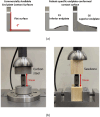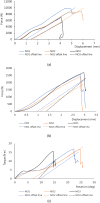Mechanical assessment of a titanium cervical spine corpectomy cage assembled with 3D-printed patient-specific endplate-conformed contact surfaces and a traditionally manufactured expandable mechanism
- PMID: 41128973
- PMCID: PMC12548260
- DOI: 10.1186/s41205-025-00299-2
Mechanical assessment of a titanium cervical spine corpectomy cage assembled with 3D-printed patient-specific endplate-conformed contact surfaces and a traditionally manufactured expandable mechanism
Abstract
This study developed a new titanium cervical spine expandable corpectomy cage (ECC) that consisted of two superior/inferior patient-specific endplate-conformed contact surfaces (PECSs) fabricated through 3D printing and a standardized centrally expandable mechanism (CEM) manufactured using traditional machining. Fatigue testing was conducted to evaluate whether the components of ECC could be assembled using different manufacturing methods to meet the functional testing requirements in compliance with FDA regulations. The titanium 3D-printed superior/inferior PECSs were designed based on the CT images/CAD system to assembly with a CNC milling/precision wire cutting cuboid CEM (14 mm square cross-section) expansion driven by a set of sliders interlocked via key and keyway mechanisms for the ECC of two-segmental vertebral bodies. The ECC underwent FDA-compliant static/dynamic compression, shear, torsion, subsidence tests and finite element (FE) analysis for understanding the stress differences on endplates between PECS and flat-shaped endplate contact surface (FECS). Stiffness/yield strength were found to be 2127 ± 146 N/mm/8547 ± 1213 N for the compression test, 1158 ± 139 N/mm/ 2561 ± 114 N for the shear test, and 1.22 ± 0.32 Nm/deg/16.5 ± 0.58 Nm for the torque test. Some failure samples showed that fixation screws were fractured/loosened under the shear test. The endure limits were 1600 N, 350 N and 1.0 N*m under compression, shear and torsion cyclic load tests, respectively. The results of the static axial compression and static/dynamic compression-shear testing did not meet the acceptance criteria of ISO 23,089. The PECS with higher stiffness value showed that better subsidence resistance was achieved than FECS and was consistent with that the maximum stress value and distribution for the FECS were more harmful than those for the PECS models. This study demonstrated that mechanical testing is essential when assembling 3D-printed components with CNC-manufactured parts in multi-component medical implants, as mismatches in interface behavior may result in mechanical failure. The results of FE analysis and subsidence tests indicated that PECS can decrease stress concentration between the ECC and endplates to present better performance for subsidence resistance.
Keywords: 3D printing; Cage; Dynamic test; Expansion; Patient-specific.
Conflict of interest statement
Declarations. Ethics approval and consent to participate: N/A. Consent for publication: Not applicable. Competing interests: The authors declare no competing interests.
Figures










References
-
- Elder BD, Lo SF, Kosztowski TA, Goodwin CR, Lina IA, Locke JE, Witham TF. A systematic review of the use of expandable cages in the cervical spine. Neurosurg Rev. 2016;39(1):1. - PubMed
-
- Hur JW, Ryu KS, Ahn S, Kim JS, Chung HJ, Song MS. Anterior cervical corpectomy and fusion in terms of postoperative subsidence and sagittal alignment comparative analysis of 2 different types of titanium mesh cage for single-level. Clin Spine Surg. 2020;33(1):E8–13. - PubMed
-
- Qin R, Chen X, Zhou P, Li M, Hao J, Zhang F. Anterior cervical corpectomy and fusion versus posterior laminoplasty for the treatment of oppressive myelopathy owing to cervical ossification of posterior longitudinal ligament: a meta-analysis. Eur Spine J. 2018;27:1375–87. - PubMed
-
- Zhang Y, Liu H, Yang H, Pi B. Anterior cervical corpectomy and fusion versus discectomy and fusion for the treatment of two-level cervical spondylotic myelopathy: analysis of sagittal balance and axial symptoms. Int Orthop. 2018;42:1877–82. - PubMed
-
- Cappelletto B, Giorgiutti F, Balsano M. Evaluation of the effectiveness of expandable cages for reconstruction of the anterior column of the spine. J Orthop Surg (Hong Kong). 2020;28(1):2309499019900472. - PubMed
LinkOut - more resources
Full Text Sources
Medical
Miscellaneous
